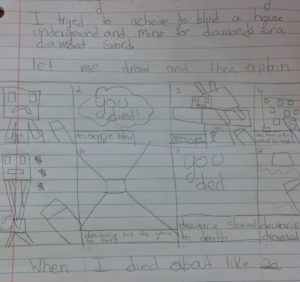Explorers and Settlements: Minecraft and Social Studies
I have often told the story of how I used Minecraft accidently to help illustrate a point I was making with my grade 5 students a few years ago. So if you have seen me present you may have already heard this one.
However this is a story that is worth repeating.
One of my biggest struggles in giving students time to play games in class is the ever present pressure to account for every minute. And, a few years ago when I regularly used games in my literacy centres there was almost always (accountable) time included for students to respond or reflect on their play related to the Language curriculum. That being said, some of my favourite moments that have come out of gaming experiences were not planned. I have already written about one here: Skin Deep a Discussion about Choice , but there are many more stories still to tell.
Three years ago I was teaching the new Heritage and Identity strand of the Social Studies curriculum to my grade 5 students. This was a bit of a struggle because it was one of the strands that had changed when the curriculum was updated; the resources I had were written for grade 6 students, and they did not always reflect the updated curriculum content or reading level of my students.

During the unit we read about Cartier and Champlain and their experiences upon arrival and how they interacted with the aboriginal people and the land. One thing the grade 5’s agreed on was that Cartier was not what they thought of as successful, and Champlain was; he was able to establish a settlement. The problem that I was having was that, when pressed, my students were unable to explain why they saw Cartier failed and Champlain a success. They could not make any comparisons or connections between the two explorers to justify their thinking, and rereading the textbook wasn’t cutting it.

At this point it was worth noting that we had been examining an overarching inquiry question (What are wants and needs?) cross curricularly. One way we explored the question was through using Minecraft. I had changed the game mode students used as we went further in our inquiry. At the very beginning of the year, I had allowed my students to use creative mode when playing Minecraft. However in October I had announced that for the time being, that when playing Minecraft during centre time they could only play in survival mode. I was hoping we could find some time to unpack the way they played in both modes and relate that our inquiry. Needless to say, the switch in game play was not met well by the students to begin with. Although it did produce some interesting writing.
One of the most useful and completely unplanned byproducts of the switch in game mode was a great teachable moment.
While sitting with my grade 5’s on the carpet trying to will them to make connections between Cartier and Champlain, as a last ditch effort, I tried to use their play experiences in Minecraft as a bridge to understanding. I was desperate. I asked about how their experience ‘in game’ changed once they were forced to play survival. They then proceeded to tell me -at length- about the many, many, times and ways they died. I asked them if that experience was still true today after being in survival mode for a couple of weeks. They responded by telling me that they had learned how to survive, and that they found that by working together and deciding on who would be ‘in-charge’ of certain tasks (building, finding food, protecting) they were able to do more. At this point I asked the grade 5’s if they could relate their experiences in Minecraft to Champlain and Cartier.
It was one of the biggest “ah ha” moments I had seen. All of a sudden students were able to tell me how in the beginning of their time in survival mode they were like Cartier and just exploring without understanding how to survive; they talked about how in his case, many of his sailors died; they saw that, along with his kidnapping of Chief Donnacona as huge failures. Then they compared how they shared responsibilities in the game to how Champlain was able to establish a settlement because he had a diverse group of people come and work with him, citing paragraphs in the textbooks on their laps. It was amazing! Their play experience provided the catalyst for them to be able to talk about why they considered Champlain to have had more success than Cartier.
As I said before, I often find it hard to justify giving students time to play during instructional time. I value play, but without a clear learning goal and success criteria for play, it is challenging to give it room; especially when there is already so much to cover in the curriculum. This was an amazing experience that affirmed my decision to allow students to play, and the value of game based learning. It was through game based learning that I was able to leverage their play experience as a way to make events that happened hundreds of years ago accessable.

Leave a Reply